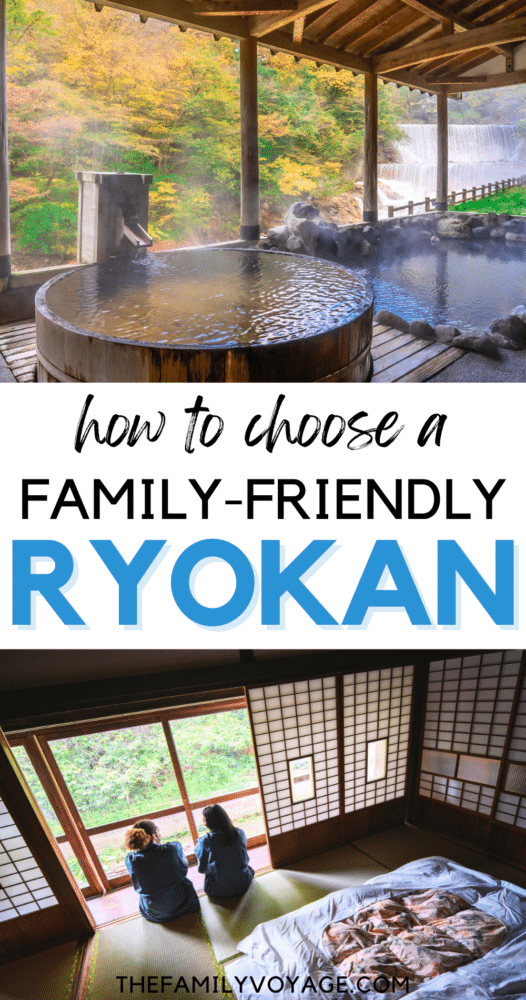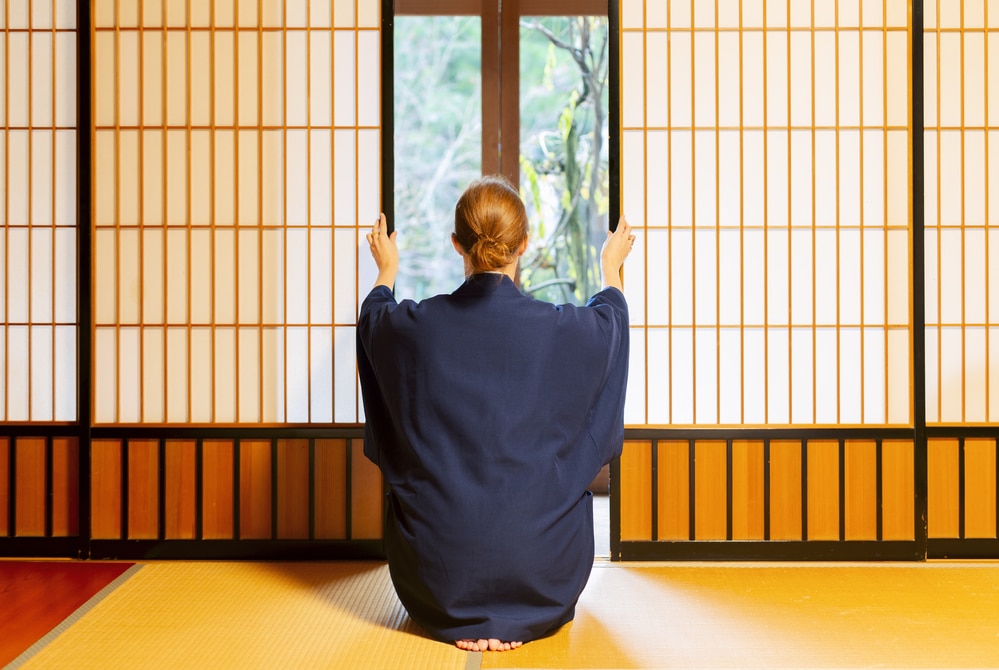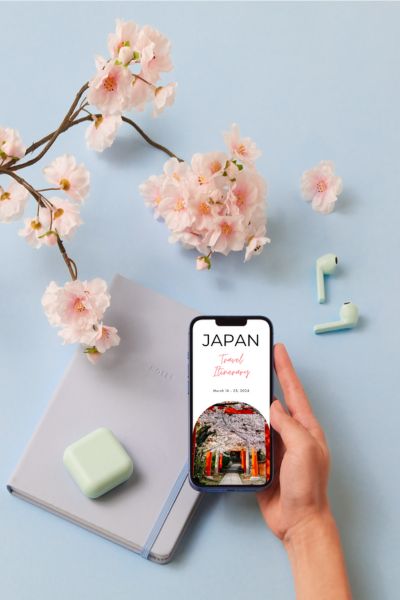One of the most unique experiences you can have on a visit to Japan is staying in a ryokan, or traditional inn. There’s nothing else quite like them in the world so you should definitely include one on your family’s Japan itinerary!
But not every ryokan is tailored toward family travelers. It’s important that you pick the right one for your needs, based on both geography and what features it offers. In this article we’ll share several hand-picked family-friendly ryokans in Japan that will delight all ages and be a true highlight of your experience! We really enjoyed the one we stayed in but it’s important to pick one that’s right for your needs.
What is a ryokan?

A ryokan is a traditional Japanese inn that offers a unique and immersive experience, perfect for families looking to explore the rich cultural heritage of Japan. You’ll usually find them in scenic areas, though some are located in smaller historic cities. They’re popular among both Japanese and tourist families so it can also be an opportunity to connect with people away from canned experiences.
Guest rooms feature tatami mat floors, sliding fusuma doors, and futon beds that are laid out on the floor each night by ryokan staff. Many ryokans also include a communal or private onsen (hot spring bath), providing a relaxing experience – and the pre-onsen shower is a great way to make sure your kids are getting clean each night before bed! Keep in mind that communal ryokans are separated by gender and everyone is in their “birthday suit”, so consider your child’s comfort level as you weigh ryokans with private versus shared onsen.

If you plan to visit an onsen with kids, be sure they know what to expect. They’ll sit on a little stool to clean themselves and then immerse themselves naked around other guests. Of course they don’t have to be silent, but the general expectation is that they be calm and respectful. The water is extremely hot, so don’t be surprised if your kiddo spends most of the time sitting on the side or goes back and forth often. Girls and women with long hair will need to put it up before going into the onsen.
Guests can enjoy kaiseki dinners, a multi-course meal that showcases seasonal and regional specialties, often served in the privacy of their own room – at some ryokans dinner is included in the rate, while at others it’s an option. Breakfast is nearly always included and reflects both national and regional specialties. You’ll often find miso soup, various types of fish, rice, an egg dish and some vegetables.

The experience is rounded off with the wearing of yukatas (casual summer kimono), enhancing the cultural immersion. You’ll also be given slippers to wear as you walk around the building (which should be removed and stored in a cubby when you enter your room). For families, this offers a wonderful opportunity to bond in a tranquil setting, away from the hustle and bustle of city life.
Disadvantages of staying at a ryokan
However, staying at a ryokan comes with its own set of potential pitfalls.
The first challenge is that you need to book your ryokan pretty far in advance if you want your choice of property or room. The best options fill up many months in advance. In general, lining your plans up in advance is one of the most important Japan travel tips I can offer you!
For the most part, ryokans are not a budget-friendly option. Many of them include extensive facilities and meal plans, and you pay for those features.
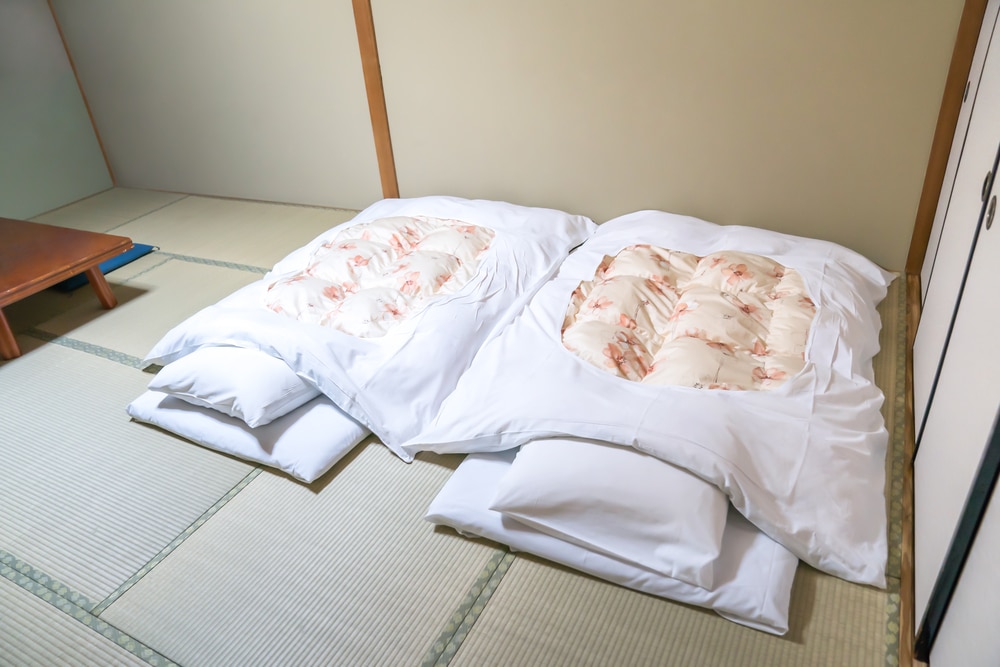
The traditional setup means sleeping on futons on the floor, which might not be comfortable for those who have limited mobility. Some of the ryokans for families in this article offer mixed Japanese-Western rooms, which can be a good compromise if you need it.
Both breakfast and dinner at a ryokan can be challenging if you have dietary restrictions; after trying in vain to explain the things we don’t eat, in retrospect I should have instead just given a list of what we do eat. Prepare for well-intentioned dining staff to have basic English language skills but not all of the nuance to understand your food needs.

Lastly, some very traditional ryokans may have rigid schedules and rules in place (this is less of a factor at high-end ryokans that serve a mix of Japanese and Western guests). It’s part of the experience but can rub some people the wrong way.
What makes a ryokan family-friendly?
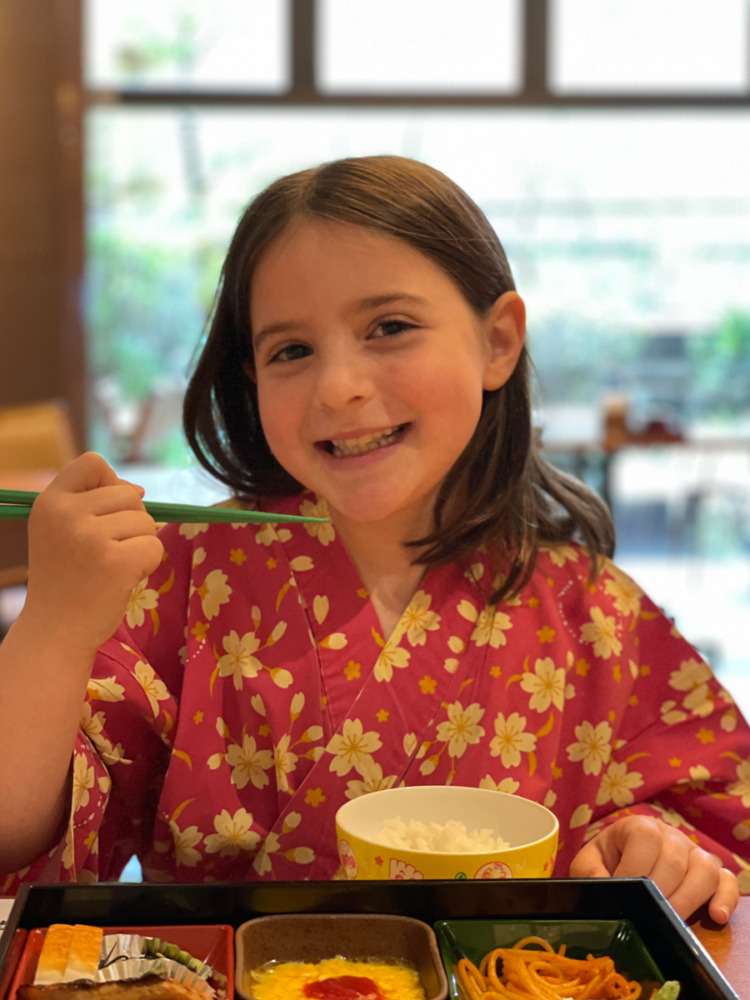
While many ryokans allow kids, they aren’t all created equal when it comes to meeting a family’s needs. A few features to look for based on your on situation include:
- rooms large enough to accommodate everyone
- child-sized yukata robes (be sure to know their height in centimeters)
- simplified kid-friendly food options, with high chairs if necessary
- onsen allows children
- child amenity kits – not a necessity, but they’re so fun and made my daughter feel extra special!
Best family-friendly ryokans in Japan
To some extent your choice of ryokan will depend on your Japan itinerary – after all, you won’t stumble on a ryokan in a random street corner in Tokyo! Some families who really want to have this cultural experience will go out of their way to do it, so I’ve included both city and more remote options.
Miyajima Kinsuikan

I’ll start with the ryokan where we stayed, Miyajima Kinsuikan on charming Miyajima Island. It’s a short ferry ride from the city of Hiroshima but truly a world away. Miyajima Island looks much like it did centuries ago, with a striking shrine and quaint village set against the backdrop of towering Mount Misen. Staying at Kinsuikan only adds to the experience; this 39 room inn retains so much of the island’s historic character while adding modern touches.
Upon arriving you’ll receive a wooden key, a basket for each person to carry their belongings to the basement onsen, wooden-soled sandals and a yukata of your choosing. They have a wide range of designs and sizes, and behind the desk they stock lots of childrens’ sizes. Our daughter was so thrilled with her yukata that she wore it as we explored the island!
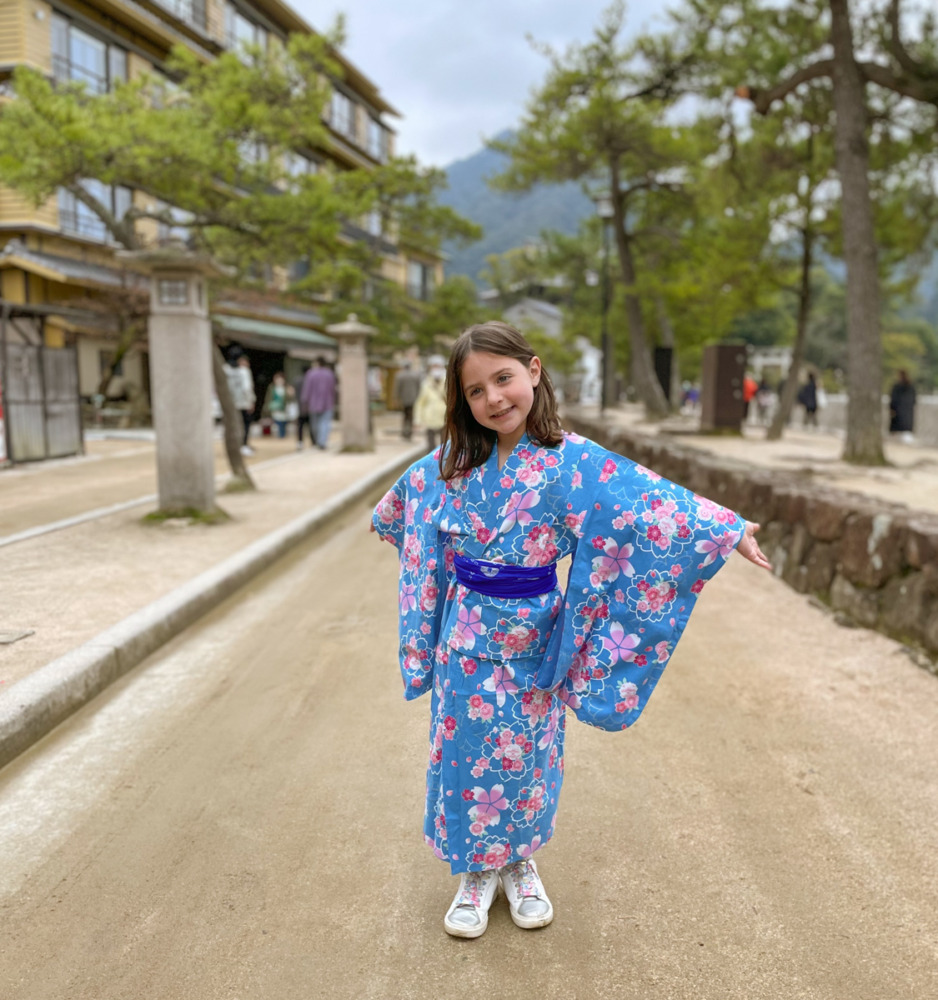
Our room was plenty spacious for our family of four and had a very traditional layout – bathroom and closet near the entry, main room for a low table and chairs by day or four futons by night, and finally a small sitting room at the back with a couch and chair. All of the flooring is made of tatami mats and guests are expected to place shoes on the shelves near the entry rather than wear them into the room. I am not generally a great sleeper but we found the futons extremely comfortable. We all slept like babies!
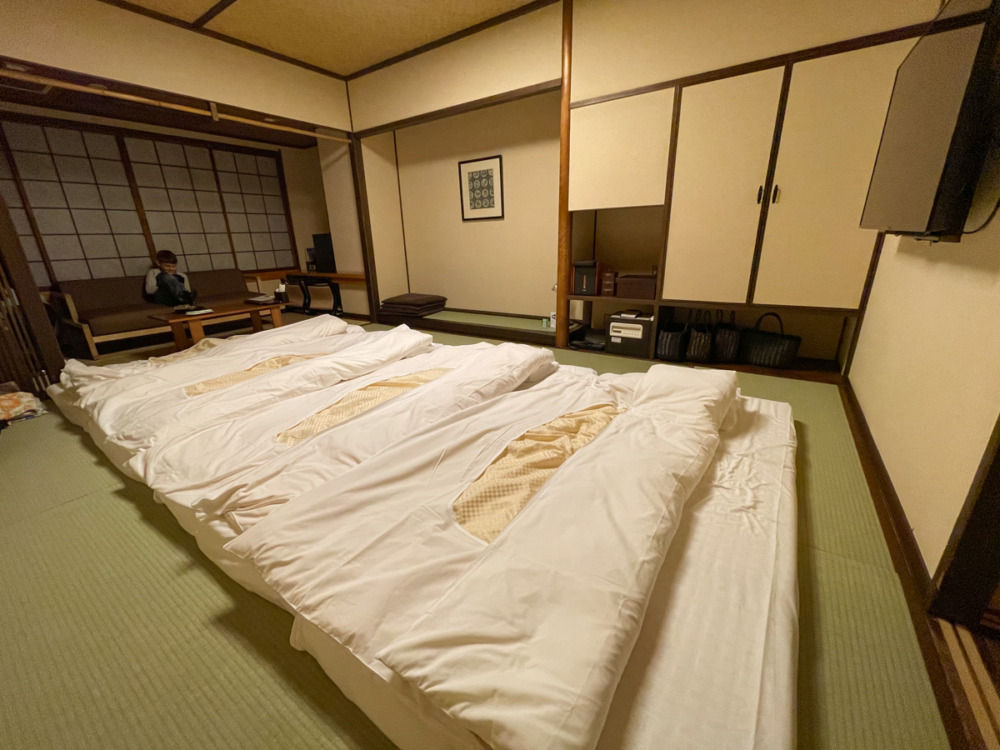
The bathroom wasn’t fancy, other than the toilet (obviously) but in reality we didn’t use the room’s shower at all since the onsen is a highlight of staying here. There were nice amenities provided, including an adorable amenity kit for kids that included a small toothbrush, a tiny tube of strawberry sakura toothpaste and even a very kawaii washcloth – the perfect souvenir. Since they know you’ll be using the onsen, there’s a folding comb and hair ties provided as well. There are also separate sandals provided for the bathroom, in line with Japanese custom.
We used the gender-separated public onsen each evening of our two-night stay and it was a wonderful way to relax! We encountered a few other guests there, including another mother and child. The onsen facilities are clean and nice, with plenty of products to use to clean yourself before bathing and to pamper yourself afterward. Though we visited at the beginning of the busy tourist season, it never felt crowded and there was plenty of space for everyone.
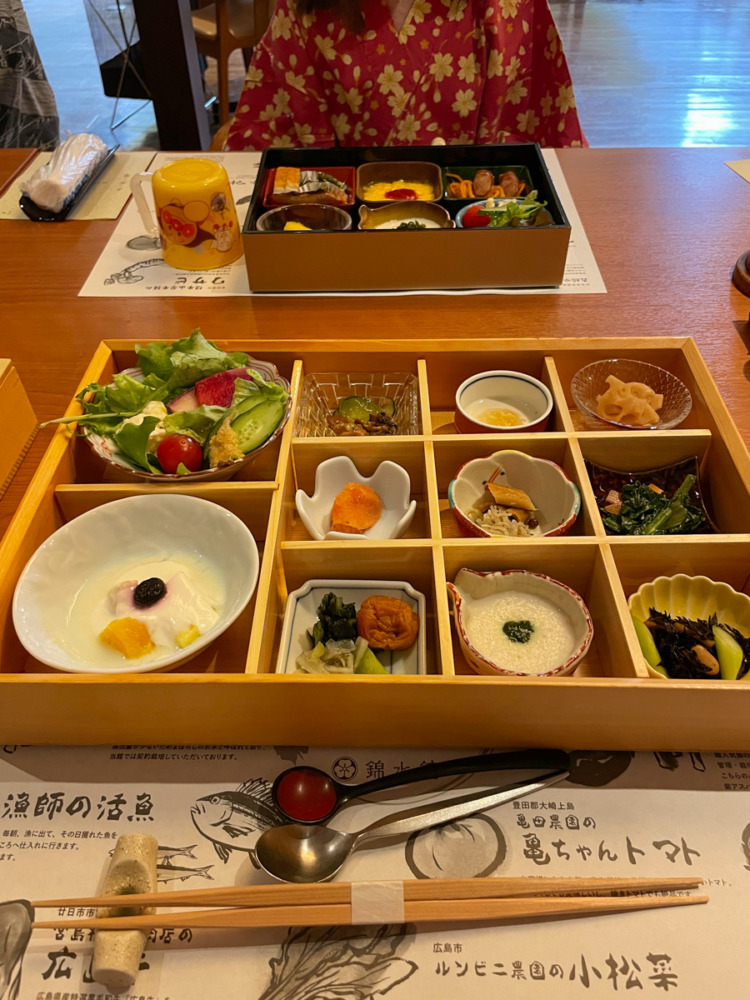
The dining was a challenge for us (as I alluded to earlier) but is probably amazing for people without dietary restrictions. The entire Hiroshima region is known for its seafood and the breakfast menu reflects that. While our daughter was served a children’s meal of rice, miso soup, egg and salmon the rest of us received a bento box full of delicacies that we don’t eat. I did request “no shellfish” when booking, but I think the language barrier (rather than ill intentions) made the situation challenging despite repeated attempts. In the interest of full transparency, the kids and I went to Starbucks down the street so that we wouldn’t go hungry. If you have no dietary restrictions and are at all adventurous in your eating, you’ll love it!
Matsui Honkan

I had actually booked Matsui Honkan initially and only changed our reservation because of a scheduling change that necessitated it. It’s one of the best family-friendly ryokans in Kyoto and has a fantastic location in the Karasuma area – you’ll get the best of both worlds as you blend convenience for your Kyoto itinerary with a unique Japanese cultural experience. It was built in 1933 and has been thoughtfully updated so this is a great place to experience a taste of pre-War Japan.
Read more: Best Family Hotels in Kyoto
Depending on the size of your family, you can book a room for 4, 6 or even 10 people – it’s ideal for a multi-generational trip to Japan. At check in, guests of all ages will receive a yukata robe. There are spacious public onsen baths for men and women in the basement and they open at 4 every afternoon so your family can relax and clean up after a long day of sightseeing.

You also have the option of booking a room-only rate or including breakfast with your stay. Making breakfast option is great for those with dietary restrictions who might find the included breakfast challenging to navigate.

If you’re visiting Japan with a toddler or baby, Matsui Honkan is a great option! They have tons of baby gear available to borrow, including a diaper bin, waterproof mattress pad, high chairs, a bouncy seat, bottle sterilizers and more.
Hakone Kowakien Ten-yu

For a true getaway, head to the mountain town of Hakone near Mt. Fuji. The area offers lots of interesting and unique activities, and there’s no better place to stay in Hakone with kids than Hakone Kowakien Tenyu. Honestly I wish we’d had time to stay overnight there rather than squeezing in our rushed day trip!
This hotel’s onsen setup is unique in a few ways worth pointing out. First, the onsens here aren’t in the basement – one is a rooftop open-air “infinity pool” style boasting amazing mountain views, while the other is open to the forest and nearby waterfall. Men and women alternate days with each of these baths so make sure you schedule bathing for two days in a row! Second, Kowakien Tenyu is one of the few onsens in the area that allows guests to wear a special swimsuit – self-conscious tweens and teens might appreciate this option.

Additionally, all of this hotel’s 150 rooms have an open-air bath on the balcony! That’s really hard to beat. The rooms here are mostly for four people, with a few options for 2 or 4. Be sure to pay attention to whether you’re booking a Japanese-style or mixed room – mixed rooms will generally have Western-style beds for two people and futons for the rest.
Want to organize your plans?
Grab our fully-customizable Japan digital travel planner!
Find out more
There’s plenty of child baby gear available here, including yukatas for kids as young as 3 or 4. They also offer diaper pails, baby tubs, kid-friendly toothbrushes, slippers, simple toys and more plus the option to rent a crib for kids up to 2 years old. If you’re staying longer than one or two nights, you can add on a visit to the water parks and spa facilities of Yunessun spa resort.
The food is a big focus at Hakone Kowakien Tenyu and all rates include the extensive breakfast buffet. You can also choose rates that include a sit-down dinner, but pay close attention: you choose your dinner preference (which has a fixed seating time) when you book your room!
Hotel Fuki no Mori

If you’d rather march to the beat of your own drummer and escape the crowds of tourists, check into Hotel Fuki no Mori in the beautiful historic village of Nagiso in Nagano Prefecture – most foreign visitors don’t get there because it’s 2-3 hours by public transportation whether you’re coming from Nagoya (the closest option), Tokyo or Osaka. Sometimes you can find flight deals into Nagoya, so keep your eyes peeled if you think this is the right ryokan for your family.
This is an area to visit if you’re looking for quiet – you can step back in time in the nearby Edo-era town of Tsumago, hike part of the Nakadendo trail or chase the crystal-blue waterfalls of the Kiso Valley.
The guesthouse has a few different onsens to choose from, both indoor and outdoor. Don’t miss stargazing while you hang out in the outdoor onsen at night! Kids of all ages are welcome in the onsens. There is also a private open-air onsen available by reservation.

Families looking for a traditional ryokan experience will want to choose either a Japanese-style suite (for up to 7 people) or standard room (for up to 4 people).
Hotel Fuki no Mori offers discounted rates for elementary schoolers and preschoolers, which is a nice touch since ryokans are on the pricey side. Their food comes in smaller, simplified portions and there are yukatas available in kids’ sizes. However, they don’t offer cribs or baby food so this isn’t the place to visit with an infant.
Planning your family trip to Japan
I hope this guide to choosing a family-friendly ryokan in Japan has helped you make the right choice for your family! Keep reading below to plan the rest of your family vacation in Japan:
- Buy your Japan Rail Pass
- Best Things to do in Japan With Kids: A Kid’s Take
- Essential Japan Itinerary: 10 Days of Family-Friendly Travel
- Things to do in Tokyo With Kids: Itinerary for 4 Days of Old and New
- The Best Hotels in Tokyo for Families (and How to Choose Yours)
- Visiting Kyoto With Kids: 2+ Day Itinerary + Must-Read Travel Tips
- Best Family Hotels in Kyoto
- 9 Tips for Japan Travel You Can’t Afford To Miss
- What to Pack for Japan in Spring (and What to Leave at Home)
- Awesome Pokémon Things to do in Japan
- Visiting the A-Bomb Sites in Hiroshima with Kids
- 10 Japan Cultural Activities & Attractions For Your Bucket List
Still planning? Pin this for later!
